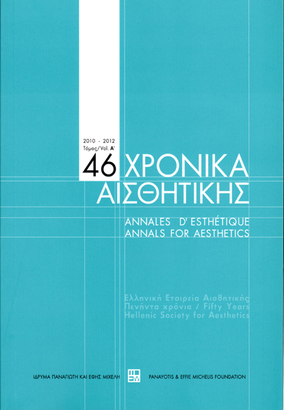Το εν δυνάμει μέτρο του σώματος διαρκής αξίας αναζήτησης αισθητικών προτάσεων : εικαστική προσέγγιση
Part of : Χρονικά αισθητικής : ετήσιον δελτίον της Ελληνικής Εταιρείας Αισθητικής ; Vol.45, 2009, pages 97-103
Issue:
Pages:
97-103
Parallel Title:
The potential measure of the human body as a constant value in pursuit of aesthetic suggestions
Author:
Abstract:
Having studied for more than 25 years the measures used in ancient Egypt and Greece, I am convinced that the knowledge of values contained therein, notably the Golden Section, could prove useful not only for an aesthetic interpretation of works of art and other works in general, but also as a knowledge of values referring to the proportions of the human body, which is the origin of these measures.The human body was studied with reverence and admiration in ancient Greece. The golden section was formulated mathematically with the Pythagorean golden ratio 1.618, which has the golden section at the point of division between 1 and 0.618. The golden section was also formulated simply with the 16 parts in the Greek measure “pous” (i.e., the Greek foot), where the golden section was placed at 10. In both mathematical and simple for mulation, the golden section has an essential and a figurative value. Thus it corresponds to the nature of the human body in its proportions and in the relations between the parts at those points where the composition of the parts creates the cohesion that gives rise to harmony.The value of the relation among the proportions of the golden section lies in the fact that it exists in the human body itself, which in turn seeks the golden section in the rest of the creation as a friendly relationship. Perhaps the word “harmony” signifies the binding, the “harmos” (connection), the composition of parts, as well as the relation of the parts with the total of the human nature. I also believe that this is what the word “truth” defines: cohesion.In the first half of the 20th century, great artists and researchers record and re-record lost values either due to commercial purposes, or just with the intention of revising. Besides, this is what always happened in the history of mankind when something was lost or was in danger of being lost. Such cases are: The Bauhaus School (1919-1933), Le Corbusier (1887- 1965), the Italian artists and anatomists in the 19th and 20th centuries, and Matila Ghyka, a Romanian researcher of harmonious drawings.All of them seek or record mainly the potential measure of the human body as a constant value in pursuit of new aesthetic suggestions, regardless of whether it is representational or abstract art. The measure with which the artist creates in all forms of art and in all eras has a friendly relationship with his body and the body of his fellow human being.
Subject:
Subject (LC):
Keywords:
Ελλάς, Αίγυπτος
Notes:
Η διάλεξη πραγματοποιήθηκε στις 2 Απριλίου 2008




